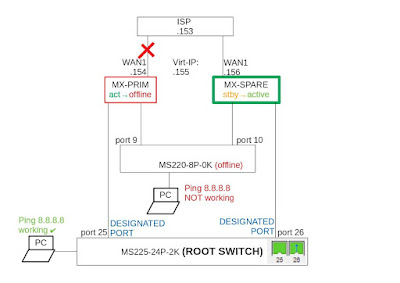Had an issue with Cisco Catalyst 2960 switch not assigning IP from the configured DHCP pool.
WS-C2960S-24PS-L running IOS 15.2(1)E, C2960S-UNIVERSALK9-M
First debugging DHCP events:
Wifi-cat#debu ip dhcp server events
Oct 14 14:26:23.567: DHCPD: Sending notification of DISCOVER:
Oct 14 14:26:23.567: DHCPD: htype 1 chaddr 4c00.821a.e425
Oct 14 14:26:23.567: DHCPD: interface = Vlan225
Oct 14 14:26:23.567: DHCPD: class id 436973636f204150206331363030
Oct 14 14:26:23.567: DHCPD: out_vlan_id 0
Oct 14 14:26:23.567: DHCPD: Sending notification of DISCOVER:
Oct 14 14:26:23.567: DHCPD: htype 1 chaddr 4c00.821a.e425
Oct 14 14:26:23.567: DHCPD: interface = Vlan225
Oct 14 14:26:23.567: DHCPD: class id 436973636f204150206331363030
Oct 14 14:26:23.567: DHCPD: out_vlan_id 0
Oct 14 14:26:23.567: DHCPD: subnet [10.241.102.97,10.241.102.126] in address pool Wifi-pool is empty.
Oct 14 14:26:23.567: DHCPD: Sending notification of
ASSIGNMENT FAILURE:
Oct 14 14:26:23.567: DHCPD: htype 1 chaddr 4c00.821a.e425
Oct 14 14:26:23.567: DHCPD: remote id 020a00000af166630c000000
Oct 14 14:26:23.567: DHCPD: interface = Vlan225
Oct 14 14:26:23.567: DHCPD: class id 436973636f204150206331363030
Oct 14 14:26:23.567: DHCPD: out_vlan_id 0
Oct 14 14:26:23.567: DHCPD: Sending notification of
ASSIGNMENT_FAILURE:
Oct 14 14:26:23.567: DHCPD: due to:
POOL EXHAUSTED
Oct 14 14:26:23.567: DHCPD: htype 1 chaddr 4c00.821a.e425
Oct 14 14:26:23.567: DHCPD: remote id 020a00000af166630c000000
Oct 14 14:26:23.567: DHCPD: interface = Vlan225
Oct 14 14:26:23.567: DHCPD: class id 436973636f204150206331363030
Oct 14 14:26:23.567: DHCPD: out_vlan_id 0
Then checking the affected DHCP pool for statistics:
Wifi-cat#sh ip dhcp pool Wifi-pool
Pool Wifi-pool :
Utilization mark (high/low) : 100 / 0
Subnet size (first/next) : 0 / 0
Total addresses : 30
Leased addresses : 0
Excluded addresses : 7
Pending event : none
1 subnet is currently in the pool :
Current index IP address range Leased/Excluded/Total
0.0.0.0 10.241.102.97 - 10.241.102.126 0 / 7 / 30
I see that 0 addresses are leased, 7 excluded and 30 total- should be enough free addresses to lease.
But current index shows
0.0.0.0 which means:
The Current index for the first two subnets is 0.0.0.0, indicating that each of these subnets has used all its available addresses.
http://www.cisco.com/c/en/us/td/docs/routers/10000/10008/configuration/guides/broadband/bba/odap.html#wp1073035
Checking the conflicts database indicates that there are no conflicts.
Wifi-cat#sh ip dhcp conflict
But still, just in case I tried clearing the conflicts:
Wifi-cat#clear ip dhcp pool Wifi-pool conflict *
As a result the DHCP server started leasing IPs and the current index reset itself:
Wifi-cat#sh ip dhcp pool Wifi-pool
Pool Wifi-pool :
Utilization mark (high/low) : 100 / 0
Subnet size (first/next) : 0 / 0
Total addresses : 30
Leased addresses : 1
Excluded addresses : 7
Pending event : none
1 subnet is currently in the pool :
Current index IP address range Leased/Excluded/Total
10.241.102.102 10.241.102.97 - 10.241.102.126 1 / 7 / 30
Don't know why this situation happened. Could be a software bug? Still investigating.
It is somewhat similar to the previous DHCP issue I described before:






